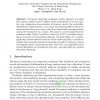Free Online Productivity Tools
i2Speak
i2Symbol
i2OCR
iTex2Img
iWeb2Print
iWeb2Shot
i2Type
iPdf2Split
iPdf2Merge
i2Bopomofo
i2Arabic
i2Style
i2Image
i2PDF
iLatex2Rtf
Sci2ools
AIRS
2006
Springer
2006
Springer
Natural Document Clustering by Clique Percolation in Random Graphs
Document clustering techniques mostly depend on models that impose explicit and/or implicit priori assumptions as to the number, size, disjunction characteristics of clusters, and/or the probability distribution of clustered data. As a result, the clustering effects tend to be unnatural and stray away more or less from the intrinsic grouping nature among the documents in a corpus. We propose a novel graph-theoretic technique called Clique Percolation Clustering (CPC). It models clustering as a process of enumerating adjacent maximal cliques in a random graph that unveils inherent structure of the underlying data, in which we unleash the commonly practiced constraints in order to discover natural overlapping clusters. Experiments show that CPC can outperform some typical algorithms on benchmark data sets, and shed light on natural document clustering.
AIRS 2006 | Clustering Effects | Document Clustering | Document Clustering Techniques | Information Management |
| Added | 20 Aug 2010 |
| Updated | 20 Aug 2010 |
| Type | Conference |
| Year | 2006 |
| Where | AIRS |
| Authors | Wei Gao, Kam-Fai Wong |
Comments (0)

